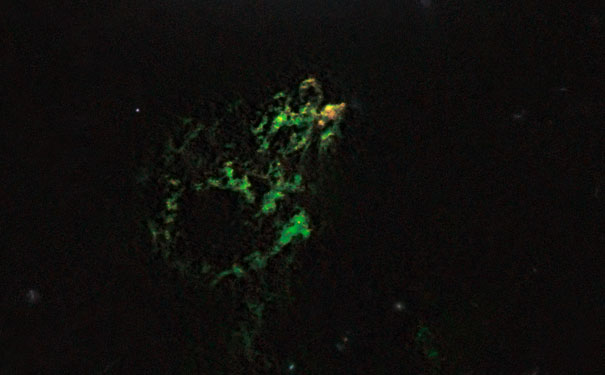
The Hubble Telescope has captured a space oddity. Image: NASA, ESA, W. Keel (University of Alabama), and the Galaxy Zoo Team
An ongoing probe of the mysterious Hanny’s Voorwerp has revealed a star nursery and a galaxy’s rough life. NASA’s Hubble Telescope has discovered a pocket of young stars clusters and gas filaments within a glowing green blob of gas the size of the Milky Way.
Hanny’s Voorwerp (“˜Hanny’s object’ in Dutch) was first discovered in 2007 by Hanny van Arkel, a Dutch teacher participating in the Galaxy zoo project (which enlists the public’s aid in classifying galaxies). It is located near the spiral galaxy IC 2497, approximately 650 million light-years from Earth.
Radio observations of IC 2497 have revealed gas outflow from its core. According to new images from the Hubble Telescope, this gas is interacting with a small area of Hanny’s Voorwerp and causing the collapse and formation of stars, the youngest of which are only a couple of million years old.
The leader of the Hubble Study, William Keel from the University of Alabama, (Tuscaloosa), said in the press release “The region may have been churning out stars for several million years. They are so dim that they have previously been lost in the brilliant light of the surrounding gas.”
Radio studies have also revealed that, rather than just being a cloud of gas, Hanny’s Voorwerp is part of a long twisting gas trail, 300,000 light years long, wrapped around the galaxy. The bright green blob is the only visible part, stretching between 44,000 – 136,000 light-years from IC 2497’s core.
Hanny’s Voorwerp recently caught the attention of astronomers when IC 2497’S core produced a quasar, which illuminated the gas blob. Keel says “We just missed catching the quasar, because it turned off no more than 200,000 years ago, so what we’re seeing is the afterglow from the quasar.”
IC 2497 has had a turbulent life. Keel says that the evidence suggests that IC 2497 may have merged with another galaxy about a billion years ago, expelling the gas and funnelling stars and gas to the centre to feed the black hole which powered the quasar.
The glowing gas was produced by shockwaves a million years ago and blasted out from the core. This event may have also triggered the formation of new stars. Then about 200,000 years ago, the quasar dimmed in brightness, but it could light up again if more material is fed to the black hole.
According to Keel “This quasar may have been active for a few million years, which perhaps indicates that quasars blink on and off on timescales of millions of years, not the 100 million years that theory had suggested.”







hubba roshaan butt
September 17, 2011
its awesome to have space picture so easily at net thanks buddy keep the work up..thumps up fpr you guys…:)